Lynnwood’s Transition Plan is organized into 2 parts: 1) parks, trails, and building facilities (Section 3.1), and 2) the public right-of-way (Section 3.2), which includes curb ramps, sidewalks and driveways that fall within the City’s area of responsibility.
Park, Trail, & Building Facilities
These components of park, trail and building facilities were evaluated to determine whether there were barriers in each facility that lack accessibility:
- Assembly Areas
- Bathing Facilities
- Built-in Elements
- Corridors/Aisles
- Curb Ramps
- Doors/Gates
- Dressing, Fitting, Locker Rooms, or Saunas
- Drinking Fountains
- Eating Areas
- Elevators
- Exercise Machines and Equipment
|
- Game and Sports Areas
- Hazards
- Judicial Facilities
- Kitchens
- Libraries
- Other Features
- Outdoor Constructed Features
- Parking Areas
- Passenger Loading Zones
- Picnic Areas
|
- Play Equipment Areas
- Ramps
- Restrooms
- Rooms
- Signs
- Stairways
- Swimming Pools/Wading Pools/Spas
- Telephones
- Trails
- Walks
|
Note: The ballfields at Meadowdale Playfields and public spaces at Development and Business Services were under construction at the time of the initial ADA evaluation. These will be evaluated in mid to late 2021 and barrier information will be provided as updates to the Lynnwood Self-Evaluation & Transition Plan.
What Types of Barriers Were Identified at the City’s Parks, Trails, & Building Facilities?
All barriers associated with Parks, Trails, and Building Facilities were identified as being within a Category of 1-4:
Category 1: The highest category is placed on those barrier removal items that provide accessibility at the main entrance of a facility or improve a path of travel to the portion of the facility where program activities take place (e.g., parking, walks, ramps, stairs, doors, etc.).
Category 2: A second category is placed on those barrier removal items that improve or enhance access to program use areas (e.g., transaction counters, conference rooms, public offices, restrooms, etc.).
Category 3: A third category is placed on those barrier removal items that improve access to amenities serving program areas (e.g., drinking fountains, telephones, site furnishings, vending machines).
Category 4: A fourth category identifies areas or features not required to be modified for accessibility (no public programs located in this area, or duplicate features).
How Has Barrier Removal at Park, Trail, & Building Facilities Been Prioritized?
To develop a schedule for the removal of barriers at the City's facilities, prioritization criteria were developed with input from the ADA stakeholder group:
- Level of use by the public
- Program uniqueness
- Geographic distribution
- Critical nature of the service provided
- Identified complaints
Each facility was evaluated using the criteria above. The prioritization of the facilities resulted in a schedule for the removal of barriers.
What is the Schedule for Removing Barriers at City Parks, Trails, and Building Facilities?
The Schedules are below and can be found in Section 3.1 of the Self Evaluation & Transition Plan.
Table 3.1 City Buildings Transition Plan Phasing Schedule
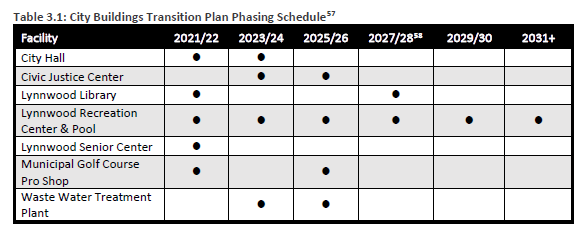
The Parks, Recreation, and Cultural Arts Department (Parks) intends to address barrier mitigation activities systematically through two approaches. The first is to address barriers with specific park elements systemwide and the second is to address maintenance and capital projects at individual park locations holistically based on the criteria for barrier removal.
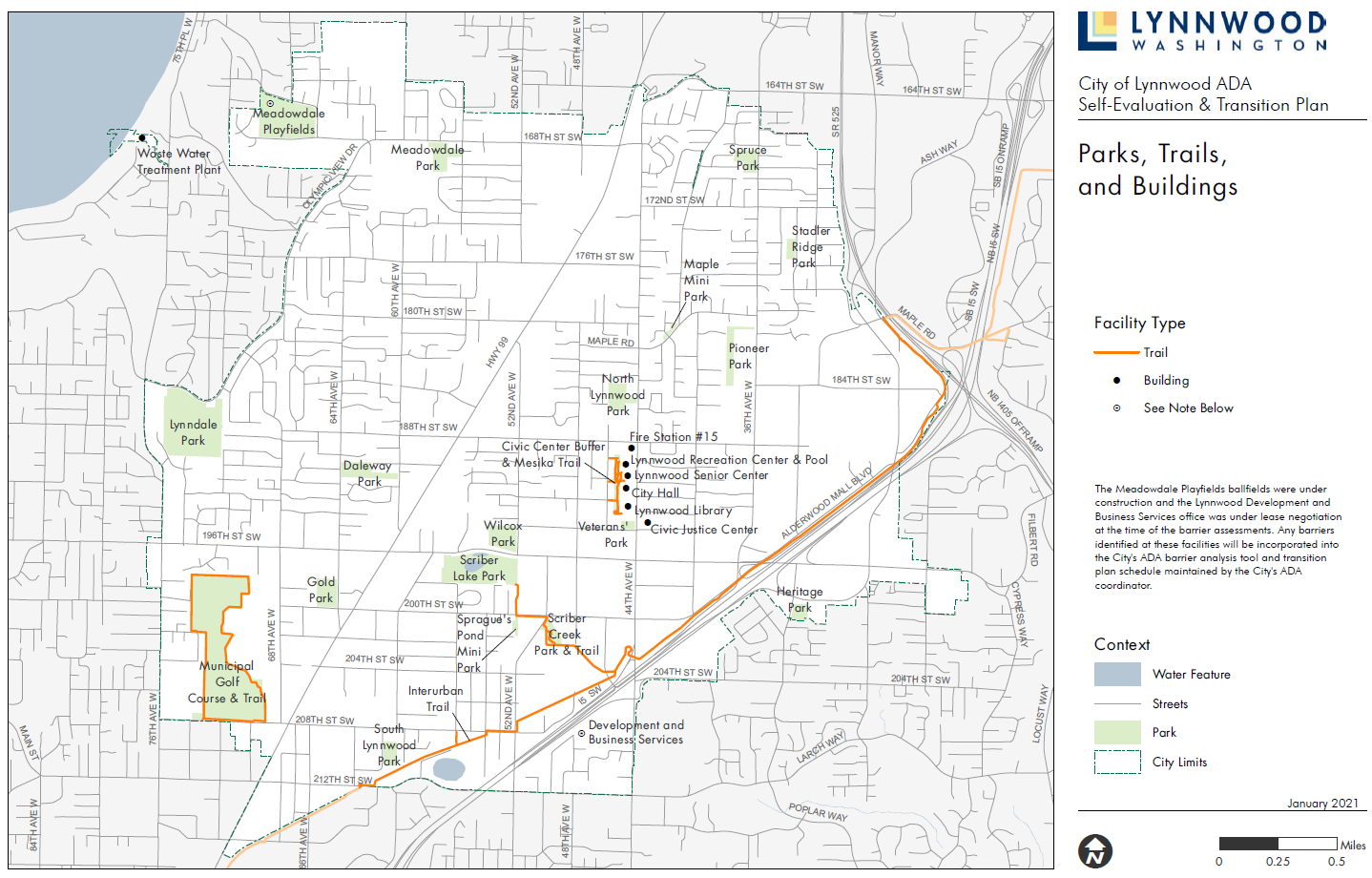 (PDF, 415KB)
(PDF, 415KB)
Click here to view map(PDF, 415KB)
The following tables illustrate the two approaches.
Table 3.2 Systemwide Park Element Transition Plan Schedule
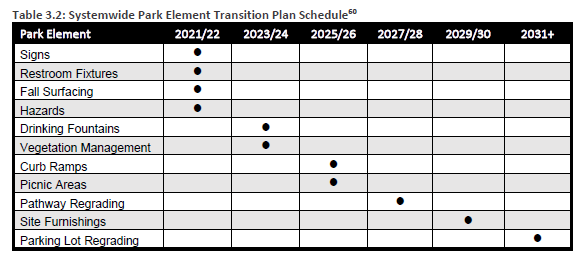
Table 3.3 Park Project Specific Transition Plan Schedule
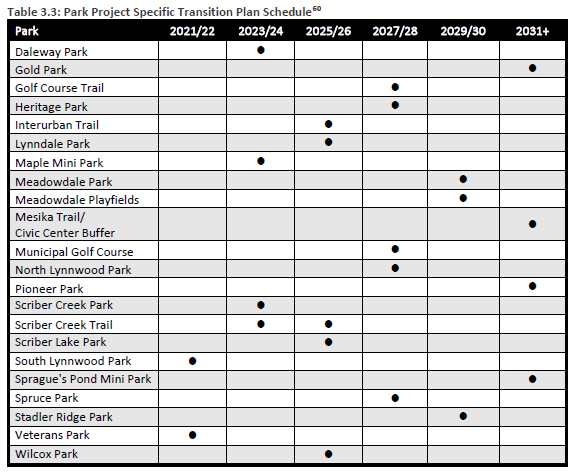
The City reserves the right to modify barrier removal priorities to allow flexibility in accommodating community requests, petitions for reasonable modifications from persons with disabilities, changes in City programs, and funding opportunities and constraints.
Recently Completed Barrier Removal Projects at Parks
During the development of this Plan the Parks Department completed 100 barrier mitigation projects of various variety and locations as noted in Table 3.4.
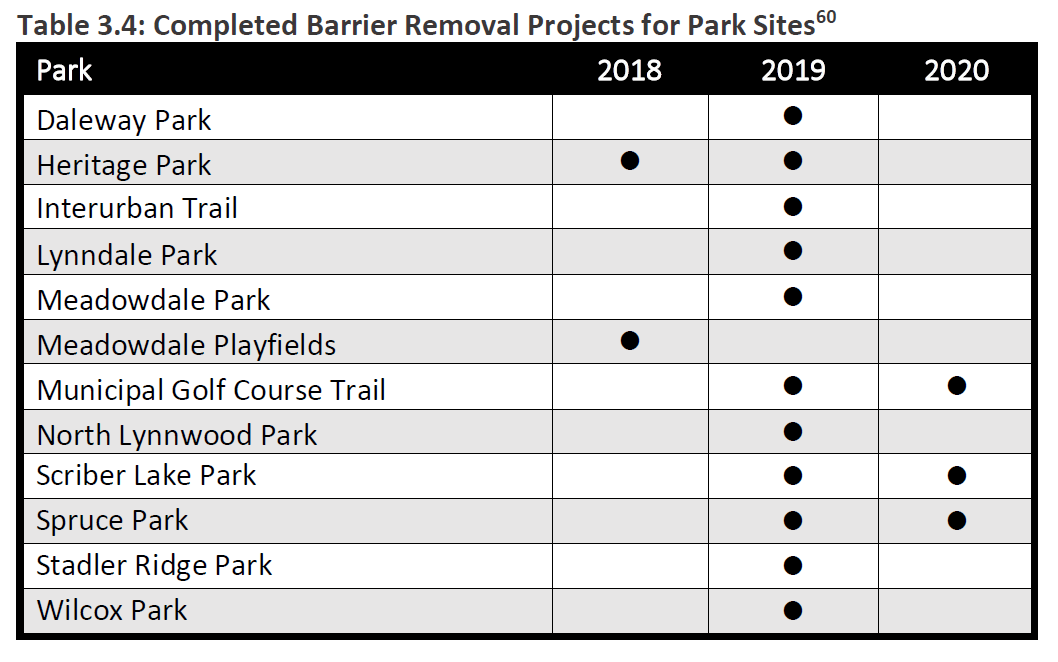
Public Right-of-Way
The ADA addresses accessible public right-of-way where sidewalks are provided by the City. The evaluations of the public right-of-way facilities included curb ramps, pedestrian access routes, and driveways. In addition, Lynnwood must have a policy for Accessible Pedestrian Signals and Pushbuttons, which can be found in Section 3.2 of the Plan.
This evaluation included assessing accessibility of 1,384 curb ramps, 138 miles of sidewalk, and more than 5,500 driveways.
What types of Barriers were Identified in the City’s Public Right-of-Way?
All curb ramps, sidewalks, and driveways were identified as being within a Category 1-4. Separate categories were defined for each of these components.
Curb Ramp Barrier Descriptions
|
Category 1:
|
- The curb ramp is significantly damaged or deteriorated and is unsafe.
- There is no accessible path of travel to the curb ramp.
- The curb ramp has no detectable warning.
- The curb ramp has no receiving ramp.
- The curb ramp has no design specifications for end of sidewalk or is an asphalt shoulder adjacent to locations serving government offices and public facilities.
|
Category 2:
|
|
Barrier located along a freeway and/or expressway or a major arterial:
- Width of ramp is less than 48 inches.
- Running slope of ramp exceeds 8.33 percent or five percent for a blended transition.
- There is a grade break on the surface of the ramp.
- A four-by-four-foot clear space at the bottom of the ramp outside of the travel lane is not provided.
- The curb ramp has no design specifications for end of sidewalk or is an asphalt shoulder adjacent to locations serving transportation.
|
Category 3:
|
- Top turning space is less than four-by-four feet or constrained space is less than four-by-five feet or slope exceeds two percent.
- Cross slope of ramp exceeds two percent.
- Counter slope of the curb ramp is greater than five percent
- The curb ramp has a lip or vertical discontinuity greater than a half-inch.
- The curb ramp has no design specifications for end of sidewalk or is an asphalt shoulder adjacent to locations serving commercial districts and employers.
- Barrier located along minor arterial or local road:
- Width of ramp is less than 48 inches.
- Running slope of ramp exceeds 8.33 percent or five percent for a blended transition.
- There is a grade break on the surface of the ramp.
- A four-by-four-foot clear space at the bottom of the ramp outside of the travel lane is not provided.
- The curb ramp has no design specifications for end of sidewalk or is an asphalt shoulder adjacent to locations serving transportation.
|
Category 4:
|
- Slope of ramp flared sides (if applicable) exceeds 10 percent.
- Diagonal curb ramp design without existing physical constraints.
- The curb ramp has a lip or vertical discontinuity less than a half-inch but greater than a quarter inch.
- The detectable warning surface does not meet standard.
- The curb ramp has no design specifications for end of sidewalk or is an asphalt shoulder adjacent to locations serving other areas.
|
Category 5:
|
- No deficiencies identified.
|
Pedestrian Access Route Barrier Descriptions (Sidewalks)
|
Category 1:
|
- The sidewalk width is less than 48 inches.
|
Category 2:
|
- Barrier located along a freeway and/or expressway or a major arterial:
- Running slope of sidewalk exceeds grade of road and is greater than five percent.
- The sidewalk has cross slopes that exceed two percent more than half the sidewalk segment.
- The sidewalk cross slope at driveway entries exceeds two percent.
- The sidewalk has a significant number of vertical changes that exceed a quarter inch –and– openings greater than a half inch or are parallel to direction of travel (more than one per 100 feet).
|
Category 3:
|
- Barrier located along a minor arterial or local road:
- Running slope of sidewalk exceeds grade of road and is greater than five percent.
- The sidewalk has cross slopes that exceed two percent more than half the sidewalk segment.
- The sidewalk cross slope at driveway entries exceeds two percent.
- The sidewalk has a significant number of vertical changes that exceed a quarter inch –and– openings greater than a half inch or are parallel to direction of travel (more than one per 100 feet).
|
Category 4:
|
- The sidewalk has cross slopes that exceed two percent less than half the sidewalk segment.
- The sidewalk has a significant number of vertical changes that exceed a quarter inch –or– openings greater than a half inch (more than one per 100 feet), but not both.
- The sidewalk has overhanging or protruding objects along its route.
|
Category 5:
|
- No deficiencies identified.
|
How Has Barrier Removal in City’s Public Right-of-Way Been Prioritized?
Prioritization criteria for assigning the barrier removal phasing schedule were developed using ADA title II requirements:
The prioritization criteria include the following:
- Locations serving government offices and public facilities;
- Locations serving transportation;
- Locations serving commercial districts and employers; and
- Locations serving other areas.
In addition to the required criteria, the City has prioritized the following:
- Location of citizen complaint/request (ADA title II Program Access)
Based on the categories and prioritization, Lynnwood established High, Medium, and Low Priority curb ramps shown on this map:
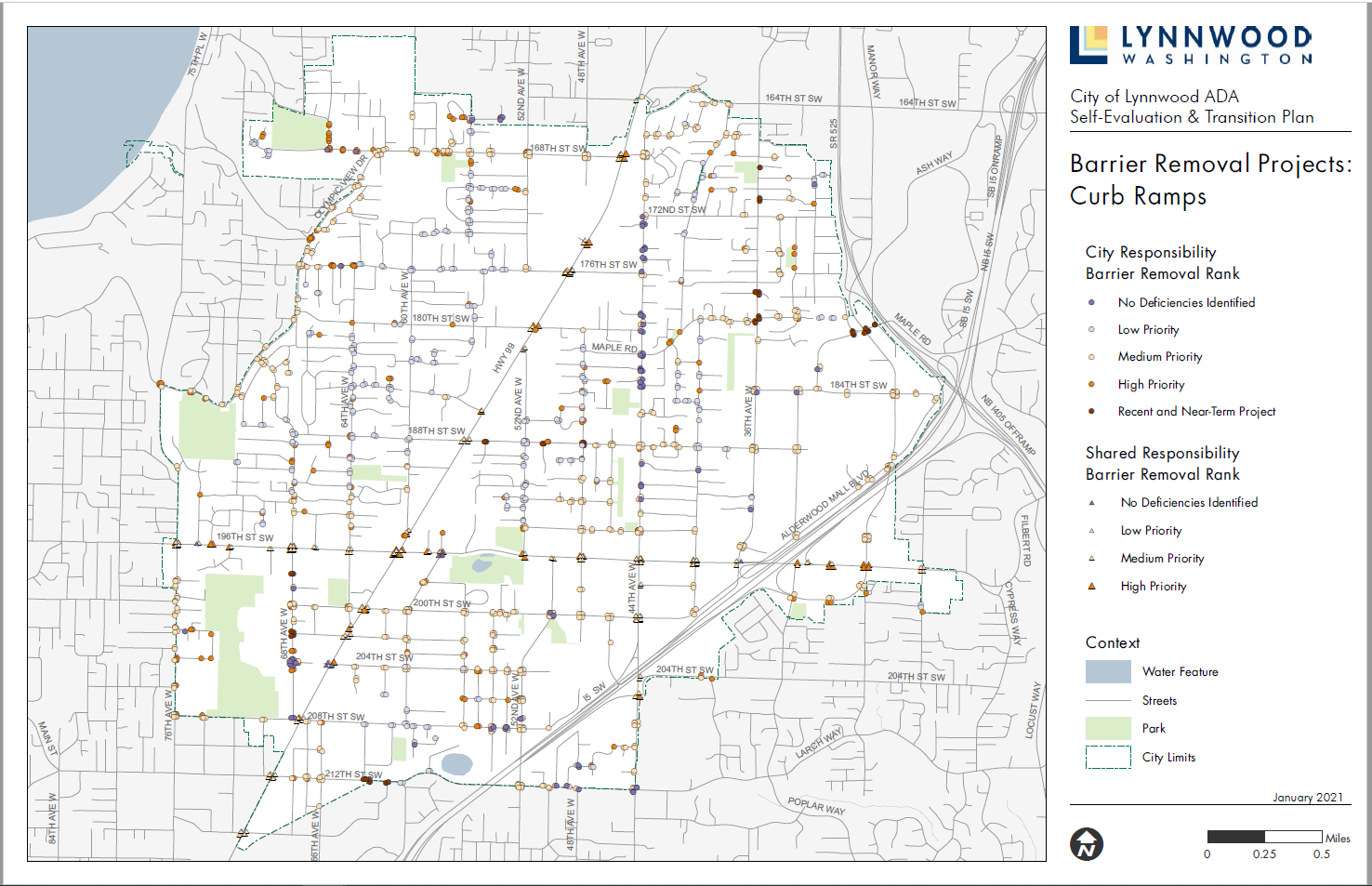 (PDF, 446KB)
(PDF, 446KB)
Click here to view map(PDF, 446KB)
How many curb ramps is that?

*WSDOT and the City have shared maintenance responsibilities for SR 99 and SR 524.
Based on the categories and prioritization, Lynnwood established High, Medium, and Low Priority sidewalks shown on this map:
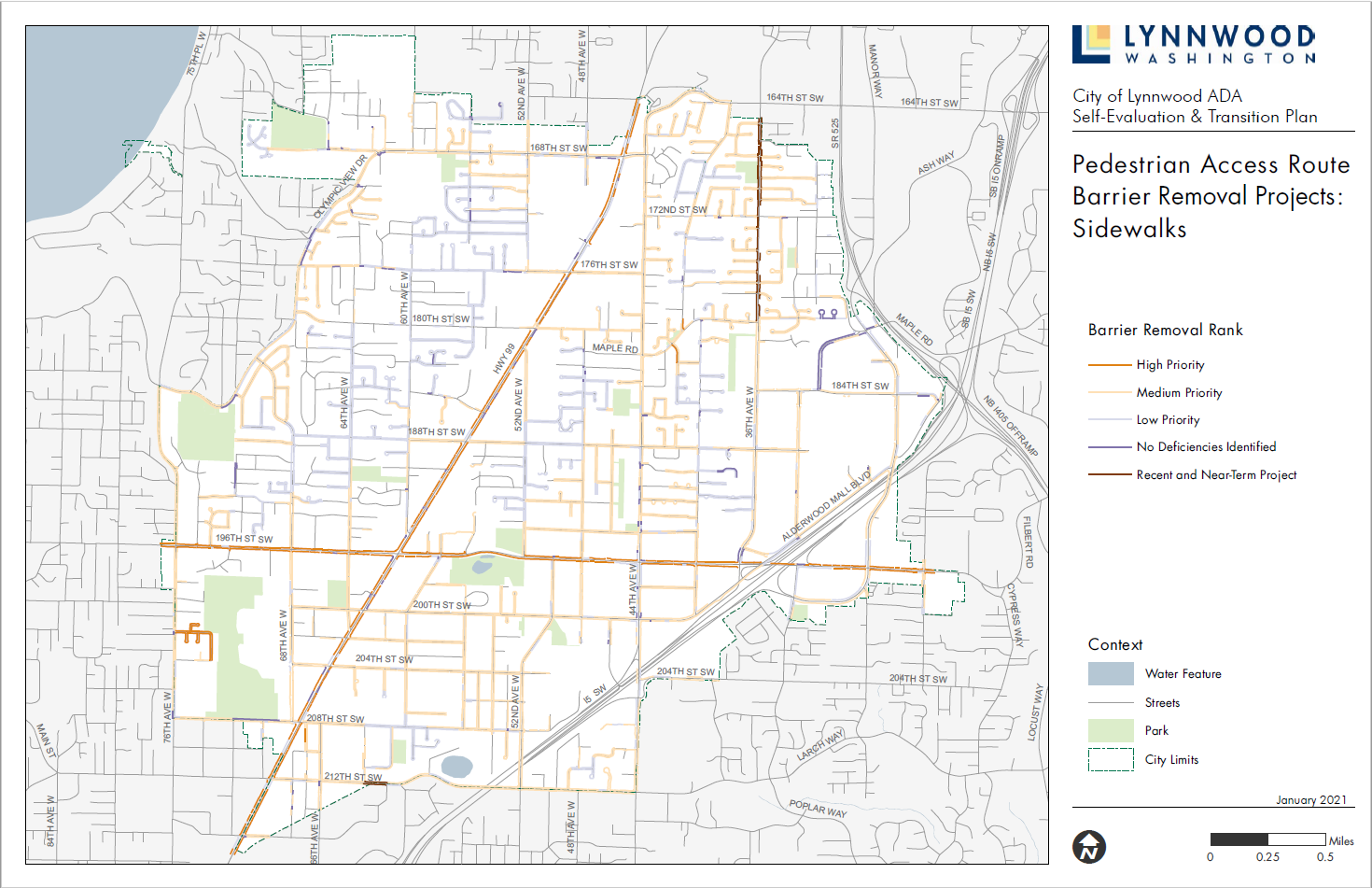 (PDF, 464KB)
(PDF, 464KB)
Click here to view map(PDF, 464KB)
How many miles of sidewalk is that?
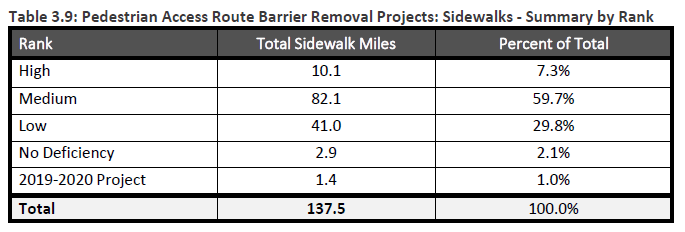
What is the Schedule for Removing Barriers Present in the Public Right-of-Way?
The City plans to address public right-of-way barriers through multiple strategies:
- The City will continue to take barrier removal requests and complete upgrades that can be completed within the operations and maintenance budget.
- The City currently has in place a pavement management program that schedules roadway rehabilitation and maintenance over a rolling five-year schedule. The City plans to review public right-of-way barriers during the implementation of this Plan and address those barriers that can be resolved as part of the on-going pavement maintenance and rehabilitation program.
- Through the pavement management plan, within the next 20 to 25 years, all arterial roadways will be resurfaced, and 776 curb ramps (56 percent) will be addressed through this process.
- Additionally, the curb ramps along State Routes 99 and 524 are roadways with shared responsibility for maintenance and operational activities between the City and the Washington State Department of Transportation (WSDOT). These ramps will be addressed through WSDOT’s pavement management program when not addressed through an alternate prioritization mechanism. This includes 182 curb ramps (13 %) which are identified in the tables and maps later in this section.
- The City will continue to provide dedicated budget for ADA barrier removal in the public right-of-way through its paving and curb ramp projects budget. This money will be used to address barriers that are not being resolved through other mechanisms. Barrier removal addressed by this strategy will be prioritized based on the criteria in this transition plan.
- The City is in the process of updating the standards and specifications for facilities in the right-of-way by following the recommendations identified during the self-evaluation process to ensure that accessible facilities are constructed. This effort will be completed in 2021.
- Any new capital construction projects will address barriers within the footprint of the project.
- The City will explore policies that address ADA barrier removal through property turnover and development policies, and then develop and implement such policies if found feasible.
- Link existing maximum extent feasible (MEF) documentation to the curb ramp inventory and develop a process of recording this MEF documentation with any alterations or new construction.
- The City will consider the development of a maintenance program for sidewalks.
- The City will explore policy options that engage property owners in the maintenance of the sidewalks adjacent to their properties.
- The City will explore options for funding sidewalk maintenance and repairs through utility improvements or a voter-approved tax.
Recently Completed Curb Ramp Projects
During the development of this Plan, the City completed various barrier mitigation projects in the public right-of-way.
2019 INTERSECTION PROJECTS
- Ash Way and Maple Rd
- Alderwood Mall Pkwy and Maple Rd
- 33rd Ave W and 30th Pl W
- 33rd Ave W and Maple Rd
- 33rd Ave W and Alderwood Mall Pkwy
- 188th St SW and 55th Ave W
- 188th St SW and 52nd Ave W
- 188th St SW and 51st Pl W
- 188th St SW and 48th Ave W
- 212th St SW and 63rd Ave W
- 212th St SW and midblock crossing east of 63rd Ave W
- 212th St SW and 61st Pl W
2020 INTERSECTION PROJECTS
- 36th Ave W and 165th Pl W
- 36th Ave W and 166th Pl SW
- 36th Ave W and 167th Pl SW
- 36th Ave W and Spruce Park entrance
- 36th Ave W and 168th Pl SW
- 36th Ave W and mid-block crossing south of 168th and southern Spruce Park entrance
- 36th Ave W and 169th St SW
- 36th Ave W and 170th Pl SW
- 36th Ave W and 171St St SW
- 36th Ave W and 172nd St SW
- 36th Ave W and 173rd PL SW
- 36th Ave W and 174th Pl SW
- 36th Ave W and 175th St SW
- 36th Ave W and 176th St SW
- 36th Ave W and 176th Pl SW
- 36th Ave W and 177th Pl SW
- 36th Ave W and 179th Pl SW
- 68th Ave W and 202nd St SW
- 68th Ave W and 200th St SW
2021 & 2022 Planned Projects
Intersections:
- 200th St SW & Scriber Lake Rd
- Scriber Lake Rd & 198th St SW
- 44th Ave W & 211th St SW
- 44th Ave W & 209th St SW
- 44th Ave W & 20800 Block
- 48th Ave W & 194th St/Veterans Way
- 196th St SW & 48th Ave W
- 196th St SW & 44th Ave W
- 196th St SW & 40th Ave W
- 196th St SW & 37th Ave W
Not intersections/but projects
- 176th St SW – 10 ramps along north side between 44th Ave W & SR99
- 3 ramps along 194th St/Veterans Way near City Hall
- 194th St/Veterans Way & 40th Ave W – 1 ramp